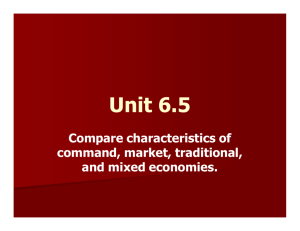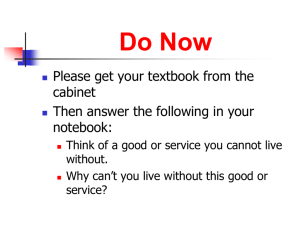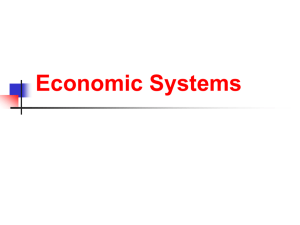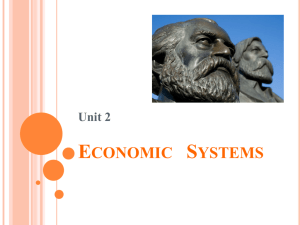12EPP Chapter 02 - Falcon School District 49
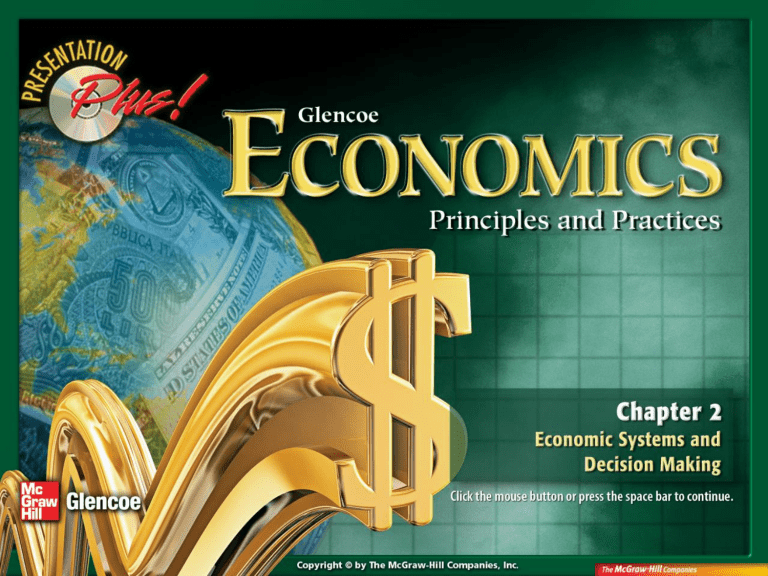
Splash Screen
Economic
Systems
Evaluating
Economic
Performance
American Free
Enterprise
Chapter Menu
Take a closer look at the way your high school is organized. Who makes the decisions on lesson plans? Who plans out events that take place during the year? Who makes financial decisions, and how? Are parents and voters involved in the educational system?
Obtain information from your school district office or the library to create a chart that lists the rights and responsibilities of people in your school district to meet the needs of education. Read Chapter 2 to learn about the different economic systems that societies set up to meet their specific economic needs.
Chapter Intro 1
Economic systems shape relationships in society.
Chapter Intro 2
Chapter Intro-End
Section Preview
In this section, you will learn about the different types of economic systems that govern WHAT goods and services to produce, HOW to produce them, and FOR WHOM to produce them.
Section 1-Preview
Content Vocabulary
• economic system • market economy
• traditional economy • market
• socialism
• communism
• command economy
• capitalism
• mixed economy
Academic Vocabulary
• stagnation
• allocate
• emphasizing
Section 1-Key Terms
Are you familiar with the similarities and differences between a market economy and a command economy?
A.
Yes
B.
No
C.
Somewhat
A. A
0%
B. B
C. C
0% 0%
A B C
Section 1
Economic Systems
• All societies use an economic system to provide for needs and wants of their people.
• Three major economic systems exist:
– Traditional
– Command
– Market
Comparing Economic Systems
Section 1
Economic Systems
(cont.)
• Most economies combine elements of the three.
Comparing Economic Systems
Section 1
Traditional Economies
Traditional societies use ritual, habit, or customs to answer the basic questions of
WHAT, HOW, and FOR WHOM to produce.
Section 1
Traditional Economies
(cont.)
• A traditional economy —use of scarce resources and economic activity is based on habit or custom.
Section 1
Traditional Economies
(cont.)
• Advantages
– Everyone knows which role to play.
– Little uncertainty on what or how to produce.
– Customs and traditions determine who is provided for.
Section 1
Traditional Economies
(cont.)
• Disadvantages
– Individuals generally not free to make decisions
– New ideas discouraged, leading to stagnation and a lower standard of living
– Strict rules defined by elders and ancestors
Section 1
Which of the following societies operate under a traditional economy?
A.
Aborigines of Australia
B.
Inuit of Canada
C.
Mbuti of central Africa
D.
All of the above
A. A
B. B
A
0%
B
D. D
0%
D
Section 1
Command Economies
Command economies rely on a central authority to make most of the economic decisions.
Section 1
Command Economies
(cont.)
• A central authority makes the major decisions in a command economy .
Section 1
Command Economies
(cont.)
• Advantages
– Can change direction drastically through emphasizing/allocation
– Health and public services available to everyone at little or no cost
Section 1
Command Economies
(cont.)
• Disadvantages
– Basic wants and needs of consumers are ignored.
– Economies tend to be unproductive, not producing a good product.
– Large decision-making bureaucracy lacks flexibility.
Section 1
Command Economies
(cont.)
– Severely limits private property rights
– Individual freedom and initiative are limited.
Section 1
Which is a disadvantage of a command economy?
A.
Large decision-making body needed
B.
Health and public services available to everyone
C.
Can change from a rural society to an industrial nation in a few decades
A
A. A
B. B
C. C
0%
B
0%
C
Section 1
Market Economies
In a market economy, consumers and businesses jointly answer the questions of WHAT, HOW, and FOR
WHOM to produce.
Section 1
Market Economies
(cont.)
• A market economy allows people to make decisions in their own best interest.
• Buyers and sellers exchange goods and services in a market .
• Market economies are based on capitalism .
Section 1
Market Economies
(cont.)
• Capitalism means that the factors of production are privately owned.
Section 1
Market Economies
(cont.)
• Advantages
– High degree of individual freedom
– Adjusts gradually to change over time
– Small degree of government interference
– Decision making is decentralized
– Large variety of goods and services
– High degree of consumer satisfaction
Section 1
Market Economies
(cont.)
• Disadvantages
– Not everyone is provided for
– May not provide enough of some basic goods and services
– High degree of uncertainty for workers and employers
Section 1
In which of the following areas do you think government needs to increase its presence?
A.
National defense
B.
Environmental protection
C.
Care for elderly and disabled
A. A
B. B
0%
A B C
Section 1
Mixed Economies
Most economies in the world today feature some mix of traditional, command, and market economies.
Section 1
Mixed Economies
(cont.)
• Most economies in the real world are mixed economies .
• When political systems are considered with economic systems, the picture gets more complicated.
• An example is socialism and its extreme, communism .
The Spectrum of Mixed Economies
Section 1
Mixed Economies
(cont.)
• The type of political system in a mixed economy is less important than the way basic economic decisions are made.
The Spectrum of Mixed Economies
Section 1
Mixed Economies
(cont.)
• Advantages of a mixed economy
– Provides assistance for some people who might otherwise be left out
– In a democratic society, voters use electoral power to affect WHAT, HOW, and FOR WHOM decisions.
– In a socialist society, FOR WHOM is addressed more directly by government.
Section 1
Mixed Economies
(cont.)
• Disadvantages
– More services means higher costs for citizens overall
– In socialist countries, availability of services may be limited or quality deteriorates over time.
Section 1
What is the main advantage of a mixed economy?
A.
Ownership and control by government
B.
More services are provided at a higher cost to citizens.
C.
Provides assistance to people otherwise left out
A. A
A
B. B
0%
C. C
0%
B
0%
C
Section 1
Section 1-End
Section Preview
In this section, you will learn how economic freedom, economic security, and economic equity are related to the level of satisfaction people have with their economic systems.
Section 2-Preview
Content Vocabulary
• minimum wage
• Social
Security
• inflation
• fixed income
Academic Vocabulary
• adverse • accommodate
Section 2-Key Terms
What happens when our economic system fails to achieve its goals?
A.
Society demands laws to modify the system until needs are met.
B.
C.
D.
The government collapses.
A command society results.
Inflation occurs.
A. A
B. B
A B D. D
0%
C
0%
D
Section 2
Economic and Social Goals
Americans share several major economic and social goals.
Section 2
Economic and Social Goals
(cont.)
• In the United States, there are seven major economic and social goals:
– Economic freedom
– Economic efficiency
– Economic equity
• The minimum wage was established on a national level.
• Many states established lemon laws.
Section 2
Economic and Social Goals
(cont.)
– Economic security
• Social Security was established for disabled or retired beneficiaries.
– Full employment
Section 2
Economic and Social Goals
(cont.)
– Price stability
• Inflation makes paying bills difficult for individuals on a fixed income .
• High rates of inflation discourage business activity.
– Economic growth
Section 2
Economic and Social Goals
(cont.)
• As our society evolves, more goals may become important to us.
Section 2
Do you think the current list of seven goals is enough?
A.
Yes
B.
No
A
0%
A. A
B. B
0%
B
Section 2
Resolving Trade-Offs Among Goals
Conflicts among goals can be solved by comparing the cost of a goal to its benefit.
Section 2
Resolving Trade-Offs Among Goals
(cont.)
• Individuals have different ideas on how to reach a goal or on the goal itself.
• Our economic policies have opportunity costs and trade-offs.
Section 2
Resolving Trade-Offs Among Goals
(cont.)
• In many cases, trade-offs among goals are resolved when people compare their estimate of the costs to their estimate of the benefits and then vote for candidates accordingly.
• The U.S. economy is flexible enough to allow choices, accommodate compromises, and still satisfy the majority of Americans.
Section 2
Do you support the preservation of endangered species such as the
California Channel Islands fox?
A.
Completely
B.
Somewhat
C.
Not at all
A. A
B. B
0% 0%
A B C
Section 2
Section 2-End
Section Preview
In this section, you will learn how under capitalism the basic economic decisions of WHAT, HOW, and FOR WHOM to produce are made through the free interaction of individuals looking out for their own best interests.
Section 3-Preview
Content Vocabulary
• free enterprise • profit
• voluntary • profit motive exchange
• private property rights
• competition
• consumer sovereignty
Academic Vocabulary
• incentive
• catalyst
• regulator
• mixed or modified free enterprise economy
Section 3-Key Terms
Can you name any countries that operate a free enterprise economy?
A.
Yes
B.
No
A
0%
A. A
B. B
0%
B
Section 3
American Free Enterprise
• In many parts of the world, capitalism has become the economic system of choice.
• Capitalism allows private citizens to own and use the factors of production to generate profits.
• The U.S. economy is based on free enterprise .
Characteristics of Free Enterprise Capitalism
Section 3
American Free Enterprise
(cont.)
• Capitalism and free enterprise are often used interchangeably, although meanings are different.
– Capitalism stands for the private ownership of resources.
– Free enterprise is the unhindered use of privately owned resources to earn profits.
Characteristics of Free Enterprise Capitalism
Section 3
Characteristics of Free Enterprise
Capitalism
The American economy incorporates the main characteristics of a free enterprise economy.
Section 3
Characteristics of Free Enterprise
Capitalism
(cont.)
• There are five major characteristics of a free enterprise economy:
– Economic freedom
– Voluntary exchange
Characteristics of Free Enterprise Capitalism
Section 3
Characteristics of Free Enterprise
Capitalism
(cont.)
– Private property rights
• Private property gives individuals incentive to work, save, and invest.
– Profit motive
• People are free to take risks to earn a profit .
– Competition
Characteristics of Free Enterprise Capitalism
Section 3
What is largely responsible for the growth of a free enterprise system?
A.
Competition
B.
Profit motive
C.
Voluntary exchange
0%
A. A
B. B
0%
A B C
Section 3
The Role of the Entrepreneur
Entrepreneurs are the driving force of the free enterprise system.
Section 3
The Role of the Entrepreneur
(cont.)
• Entrepreneurs
– Organize and manage land, capital, and labor to gain a profit
– Are the people who start up new businesses
– Want to “be their own boss”
– Are willing to take risks
Section 3
The Role of the Entrepreneur
(cont.)
• Entrepreneurs are both the spark plug and the catalyst of the free enterprise economy.
• Their search for profits leads to a chain of events that brings
– New products
– Greater competition
Section 3
The Role of the Entrepreneur
(cont.)
– More production
– Higher quality
– Lower prices for consumers
Profiles in Economics:
Tony Hawk
Section 3
Why might an entrepreneur fail?
A.
Not enough capital
B.
Poor product or service
C.
Not aware of competition
D.
All of the above
A. A
B. B
A
0% 0%
C
0%
D
Section 3
The Role of the Consumer
The economy in the United
States adapts to consumers’ wants.
Section 3
The Role of the Consumer
(cont.)
• Consumers ultimately determine which products are produced.
• If consumers like a new product, producers are rewarded with profits.
• Consumers not purchasing a product can cause a firm to go out of business.
Section 3
The Role of the Consumer
(cont.)
• The phrase “the customer is always right” recognizes consumer sovereignty .
• Consumers are always looking for new ideas and products.
Section 3
Do you believe that “the customer is always right”?
A.
Always
B.
Sometimes
C.
Never
0%
A. A
B. B
0%
A B C
Section 3
The Role of the Government
The economic role of the U.S. government is decided by its citizens.
Section 3
The Role of the Government
(cont.)
• The role of government stems from the desires, goals, and aspirations of its citizens.
Section 3
The Role of the Government
(cont.)
• Government has become a
– Protector
– Provider
– Regulator
– Consumer
Section 3
The Role of the Government
(cont.)
• In general, the role of government in the economy is justified whenever the benefits outweigh the costs.
• An unintended consequence of government’s role is the emergence of the mixed or modified free enterprise economy .
Section 3
The Role of the Government
(cont.)
• Some people prefer to have no government involvement in the economy — which is not possible.
• Services, like national defense and a system of laws and justice, cannot be supplied by the private sector alone.
Section 3
Do you agree or disagree with the statement that the role of government in the economy is justified whenever the benefits outweigh the costs?
A.
Always
B.
C.
Sometimes
Never
A. A
B. B
C. C
0% 0% 0%
A B C
Section 3
Section 3-End
Economic Systems Most countries have a mix of three different types of economic systems.
VS 1
Economic and Social Goals In the United States, we share several economic and social goals.
VS 2
Free Enterprise The U.S. economic system is based on the free enterprise system and is characterized by competition and private ownership of resources.
VS 3
VS-End
Figure 1
Figure 2
Figure 3
Tony Hawk
(1968 – )
• professional athlete at age
14 and best skateboarder in the world by age 16
• owner of a successful business empire based on resurgence of skateboarding and name recognition
Profile
Concepts Trans
DFS Trans 1
DFS Trans 2
DFS Trans 3
economic system
organized way in which a society provides for the wants and needs of its people
Vocab1
traditional economy
economic system in which the allocation of scarce resources and other economic activities are based on ritual, habit, or custom
Vocab2
command economy
economic system characterized by a central authority that makes most of the major economic decisions
Vocab3
market economy
economic system in which supply, demand, and the price system help people make decisions and allocate resources
Vocab4
market
meeting place or mechanism that allows buyers and sellers to come together
Vocab5
capitalism
economic system in which private citizens own and use the factors of production in order to generate profits
Vocab6
mixed economy
economic system that has some combination of traditional, command, and market economies
Vocab7
socialism
political and economic system in which the government owns and controls some factors of production
Vocab8
communism
economic and political system in which all factors of production are collectively owned and controlled by the state
Vocab9
stagnation
lack of movement
Vocab10
allocate
to assign
Vocab11
emphasizing
stressing
Vocab12
minimum wage
lowest wage that can be paid to most workers
Vocab13
Social Security
federal program of disability and retirement benefits that covers most working people
Vocab14
inflation
rise in the general level of prices
Vocab15
fixed income
income that does not increase even though prices go up
Vocab16
adverse
unfavorable or harmful
Vocab17
accommodate
to allow for
Vocab18
free enterprise
capitalistic economy in which competition is allowed to flourish with a minimum of government interference
Vocab19
voluntary exchange
act of buyers and sellers freely and willingly engaging in market transactions
Vocab20
private property rights
fundamental feature of capitalism that allows individuals to own and control their possessions as they wish
Vocab21
profit
extent to which persons or organizations are better off financially at the end of a period than they were at the beginning
Vocab22
profit motive
incentive that encourages people and organizations to improve their financial and material well-being
Vocab23
competition
the struggle among sellers to attract consumers
Vocab24
consumer sovereignty
role of consumer as ruler of the market when determining the types of goods and services produced
Vocab25
mixed or modified free enterprise economy
economy where people carry on their economic affairs freely but are subject to some government intervention and regulation
Vocab26
incentive
something that motivates
Vocab27
catalyst
something that stimulates activity among people or forces
Vocab28
regulator
someone or something that controls activities
Vocab29
To use this Presentation Plus! product:
Click the Forward button to go to the next slide.
Click the Previous button to return to the previous slide.
Click the Home button to return to the Chapter Menu.
Click the Transparency button from the Chapter Menu, Chapter Introduction, or
Visual Summary slides to access the Economic Concepts transparencies that are relevant to this chapter. From within a section, click on this button to access the relevant Daily Focus Skills Transparency.
Click the Return button in a feature to return to the main presentation.
Click the Economics Online button to access online textbook features.
Click the Reference Atlas button to access the Interactive Reference Atlas.
Click the Exit button or press the Escape key [Esc] to end the chapter slide show.
Click the Help button to access this screen.
Links to Presentation Plus! features such as Graphs in Motion, Charts in Motion, and figures from your textbook are located at the bottom of relevant screens.
Help
This slide is intentionally blank.
End of Custom Shows

